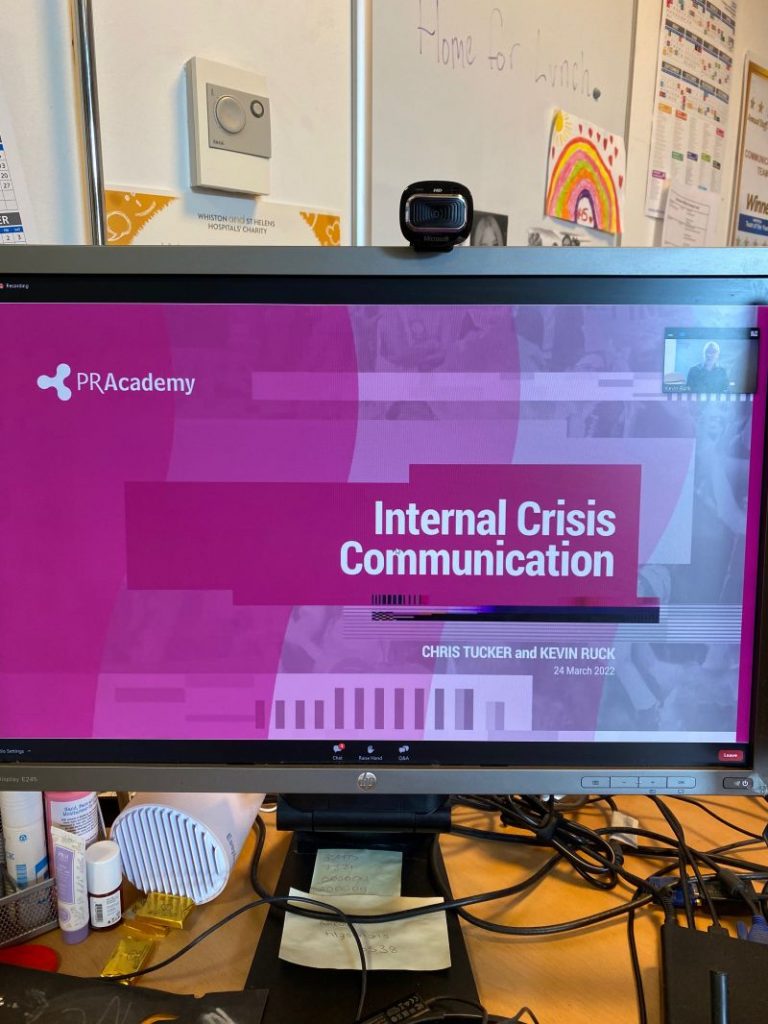Good internal communication in a crisis: Information, status and love

About the author
Chris is a lecturer, media trainer, crisis communication consultant and coach. Her in-house roles have included the global position of Director of PR for Barclays. Chris leads the CIPR PR Diploma and Crisis Comms Diplomas. BA Hons, CAM, MCIPR

One of the many changes I have seen happen in the years I have worked in PR is the move to centre-stage taken by internal communication. It is now just as likely a new senior leader will ask what do his people think of the organisation than what are the press, customers, or even shareholders saying.
Leaders have realised that it is all very leading but what if no-one is following?
The central importance of good internal communication was underlined once again during the Covid pandemic. I have always said it is when a crisis hits that PRs earn their stripes. Covid was a time when internal communication rose to the challenge and did just that. A good time then to look at the emerging theory and practice behind internal communication during a crisis.
In last week’s PR Academy Crisis Communication Hub Webinar leading IC specialist, Dr Kevin Ruck, did just that and found that whilst theory in the area was emergent to say the least there were plenty of pointers we could follow. Kevin began by reminding us of the importance of psychology in crisis communications which for the internal audience of employees is very different to that of other stakeholders.
Whilst all stakeholders may feel in uncharted territory when a crisis hits for employees that feeling of helplessness affects their very identity. The world of work may indeed have changed dramatically but it is still the case that what we do for a living is an important part of how we see ourselves. An attack on our employer in the form of a crisis can for many of us be like an attack on ourselves. As Kevin observed employees find: “A crisis threatens their sense of belonging and identity, it creates uncertainty and confusion.”
So, the first lesson is that employees are every bit deserving of the attention of the senior leadership team as the film crew banging at the door. Employees will first need some sort of reassurance which means the visibility and accessibility to them of the leadership team is very important.
When we move on to the messaging, we are in more familiar crisis communication territory. Crisis communicators talk about the importance of instructing and adjusting messaging when developing a crisis narrative. The former is designed to answer the question stakeholders have around what do I need to do because of the crisis – in a product recall what the exact product is that is impacted and what do I need to do with it?
Adjusting messaging is more around the requirement for psychological adjustment which helps the receiver judge the more medium to long term impact of what has happened on them personally. Kevin outlined that the same two-pronged message requirements also apply for Internal Communication during a crisis.
Interestingly, both Kevin and one of the attendees shared insights that during the Covid crisis some leaders had perhaps got the balance wrong. The understandable concern around well-being during Covid – the adjusting part of the message – on occasion tipped over to dominate the narrative leaving some employees unclear as to what they needed to be doing at work during such a challenging time. As the attendee observed not being sure what was required of her from the day-to-day work point of view served to add to her stress.
Do not forget that whilst the messaging for an internal audience may have some differing requirements the internal audience may well find itself having a role externally too.
There is mounting evidence that employees are a trusted source of information for other stakeholders at any time, let alone in a crisis. Employees are both receiver and communicator.
We know how porous organisations are nowadays so ensuring your employees choose to be an advocate by both understanding fully and identifying with the crisis narrative is crucial. One attendee asked how to deal with the issue of employees leaking information to the media which can in turn cause a crisis. It may sound trite but employees who feel involved, respected and whose concerns are being well-dealt with are usually much less likely to lash out in that way.
Another way of looking at the adjusting part of the messaging is through the lens of sense-making. A crisis by its very nature is a shock and outside of the norm so how are we to make sense of it and use that sense to navigate our way through these challenging circumstances? The job of the Internal Communicator is to help the leadership team develop the narrative that provides the framework employees use to make sense of what is going on around them.
Kevin referred to a recent paper from PR academics, Sarah Roberts and Liz Yeomans, that researched the ways UK universities communicated with employees in the pandemic. One of their key findings was that the narrative must change and develop as organisations work their way through a crisis. In other words, a crisis narrative cannot be like a stuck record. It must evolve as the situation evolves if it is to remain credible and authentic.
This is, as Kevin observed, a major challenge in many ways. Employees are looking for certainty. Senior managers like to be consistent in what they say. And internal communication managers are used to working with a single unifying narrative. All of these points have to be put aside in a major crisis when the situation changes regularly.
This challenge may point to a new style of leadership where leaders make a point of incorporating ongoing conversations with employees in effect co-creating the narrative. Kevin highlighted a recent interview with Sharon White, the chairman of John Lewis, when she said she saw her role being one of ‘nudge and facilitation of conversations’ as she leads the company through its recovery from the impact of the pandemic. The idea of using pulse methodology to check how employees are responding to the crisis narrative struck a chord with many attendees on the line. Also attendees pointed to the use of a facility for employees to give their comments anonymously was a useful way of gauging sentiment.
This idea of listening during internal communication – and indeed communication generally – is growing in currency. What emerges from academic research, according to Dr Ruck, is that listening may not always be appropriate in the immediate acute phase of internal crisis communication when employees expect senior managers to provide instructions and information that gives some sense to the broader impact of the crisis.
But, once that is completed, listening to employees has a significant role to play in terms of employee acceptance and advocacy. After information comes, according to one recent paper, status and even love. Status here means the ways that senior managers express their gratitude for what employees are doing. This requires a large degree of humility in leadership communication.
Love here means the ways that senior managers show their understanding of what employees are experiencing. This requires a large degree of empathy in leadership communication.
Kevin concluded by constructing a framework for internal crisis communication to remind us of how a crisis changes over time, again a familiar topic for crisis communicators and one we tackle in detail in our CIPR Crisis Communication Diploma.
The pre-crisis stage requires us to help our organisations get themselves into a good place should a crisis happen.
It’s based on principles that underpin good basic ethical internal communication that are associated with high levels of organisational engagement. As Kevin said: “In a nutshell, these are keeping employees informed about the things that want to know about and listening to employees in a meaningful way. This includes having a range of channels that employees are familiar with and like to use to get core information. The focus here is on the development of high-level senior manager communication capabilities. These can be summarised as authenticity, empathy and openness.”
During the crisis as we saw above it is about frequent communication from familiar channels of the right balance of information which helps employees maintain business as usual whilst reducing the inevitable confusion and ambiguity that any crisis brings. It also requires that senior leader visibility, accessibility, empathy and authenticity.
As with crisis communication across the piece post-crisis it is about learning the lessons. There is an opportunity to become what Kevin called “a learning community.” As he concluded: “Organisations going through a crisis can, if they adopt good practice, emerge as stronger entities.”


